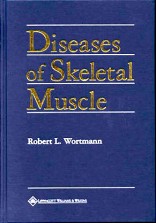|
|
|
| |
 |
|
|

|
 推薦指數:
推薦指數:





|
|
- 內容介紹
|
Diseases of Skeletal Muscle
by Robert Wortmann (Editor)
Hardcover - 380 pages 1st edition (January 15, 2000)
Lippincott Williams & Wilkins Publishers; ISBN: 0781716144
Editorial Reviews
From The New England Journal of Medicine, May 25, 2000
Neuromuscular diseases comprise a large number of clinically and etiologically diverse disorders affecting the muscle, the neuromuscular junction, the nerve, and the motor neuron. Among them are genetic, autoimmune, toxic, viral, and metabolic diseases. Because of their complexity, the investigation of these diseases necessitates expertise not only in the associated clinical phenomena but also in electrophysiology, muscle morphology, biochemistry, genetics, immunology, and therapeutics. The need to synthesize clinical and laboratory information in order to arrive at the proper diagnosis was conceived in the 1960s at the National Institutes of Health by G. Milton Shy, who began training physicians to become diagnosticians in neuromuscular diseases. Shy, and subsequently W.K. Engel and their disciples, are credited for generating a breed of experts in neuromuscular diseases, who since the 1970s have been recruited by the neurology departments of almost every medical school to run neuromuscular clinics. Financial support from the Muscular Dystrophy Association has been instrumental in enhancing the mission of these clinics and in fostering clinical research, patient care, and therapeutic-drug trials. As a result, new diagnostic techniques have been discovered; the pathogenesis of various metabolic, genetic, biochemical, and immunologic diseases has been clarified; and new therapies have been instituted.
Although neuromuscular clinics address every neuromuscular disease, the study of inflammatory myopathies has traditionally been shared by neurologists and rheumatologists. The genesis of this book is the editor's realization that over his years of practicing rheumatology, "not all muscle weakness was caused by polymyositis." This admirable confession not only provides the reason for putting this book together but also justifies the selection of topics and the recruitment mainly of authors with similar background and experience. The book is an attempt to educate rheumatologists who see patients with inflammatory myopathies and to warn them of the perils of misdiagnosis, while at the same time transmitting the editor's enthusiasm and fascination with the various muscle disorders that may mimic polymyositis. Consequently, half the book is devoted to inflammatory myopathies. Although the authors have done quite well in reviewing the field, the reader will be disappointed not to find the practical pearls of wisdom and experience that are often expected from such experts in the field.
The book is organized into three parts, which are not connected with each other. Part I covers muscle architecture and function. The information is simple for a specialist in neuromuscular diseases but sufficient for the general physician. Part II is highly heterogeneous in quality and content, with chapters overlapping in information but in a nondidactic manner. Five chapters are devoted to inflammatory myopathies but contain repetitive and sometimes unnecessary or unsubstantiated details that may overwhelm the general physician. For example, the pathogenesis of the inflammatory myopathies is covered three times, once with respect to the adult disease, again in another chapter with respect to the disease in children, and a third time in a chapter devoted to autoantibodies, even though these are primarily of research interest. The most frequent and often misdiagnosed form of inflammatory myopathies, inclusion-body myositis, is covered minimally despite the explosion of clinical and laboratory data in the field. A separate chapter is devoted to sarcoidosis, although it is a rare cause of myopathy.
The focus on inflammatory myopathy allows little space for the other, more common disorders. The muscular dystrophies, myasthenias, myasthenic syndromes, neuropathic disorders, and congenital myopathies are only briefly mentioned. The channelopathies, myotonias, and mitochondriopathies are barely covered despite their importance in general medical practice and the emerging wealth of knowledge about their mechanisms. Instead, there is extensive coverage of fibromyalgia and asthenic syndromes, two common but ill-defined and poorly understood clinical phenomena. Rhabdomyolysis is given its own chapter, but the diagnosis, mechanism, and management of malignant hyperthermia, which is the most preventable cause of rhabdomyolysis, are discussed briefly and not in the same chapter, as expected. Part III, which covers approaches to patient care, is the best part of the book. It contains useful material but lacks practical information on genetic counseling and genetic studies and a practical step-by-step approach to diagnosis.
In summary, the explosion of new information on muscle disorders is not evident in this book, and neither practical guidelines nor illustrations that would help generalists understand the common neuromuscular disorders and teach the "diseases of the skeletal muscle," the editor's goal, are conspicuous. As compared with currently available textbooks of similar size on muscle diseases, this book is only selectively informative.
Marinos C. Dalakas, M.D.
Copyright © 2000 Massachusetts Medical Society. All rights reserved. The New England Journal of Medicine is a registered trademark of the MMS.
Book Info
Univ. of Oklahoma, Tulsa. Provides a broad view of skeletal muscle, discussing normal tissue, disease and manifestations, and treatment. For clinicians and educators. Includes a section on the approach to the patient. Color and halftone illustrations in a variety of formats. Referenced. DNLM: Muscle, Skeletal.
|
|
|

